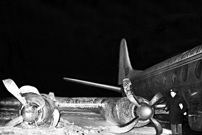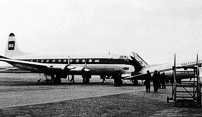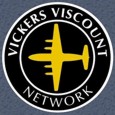
March 1953 to December 1963
British European Airways Corporation (BEA)
G-AMOA - c/n 9 - a V.701 series Viscount
United Kingdom registered
28 March 1953
Registered to British European Airways Corporation (BEA), Keyline House, Ruislip, Middlesex.
16 April 1953
Certificate of Airworthiness issued.
17 April 1953
Delivered to British European Airways (BEA) named as 'R M A George Vancouver'.
It was fitted with Rolls-Royce Dart RDa3 Mark 505 engines.
The cabin was fitted out with a 47 seat all-tourist class layout.
28 July 1953
Set up a new route record of 121:53 minutes between London Airport (Heathrow), Middlesex, England and Kastrup Airport, Copenhagen, Denmark averaging 299.5 mph.
It was flown by Captain R F Noden.
14 September 1953
Noted at Blackbushe Airport, Hampshire, England due to a London Airport (Heathrow) weather diversion.
15 October 1953
Ferried to Vickers-Armstrongs (Aircraft) Ltd at Wisley Airfield, Surrey, England for modification work.
31 October 1953
Returned to BEA at London Airport (Heathrow), Middlesex, England.
26 May 1954
Ferried to Vickers-Armstrongs (Aircraft) Ltd at Wisley Airfield, Surrey, England for modification work.
4 June 1954
Returned to BEA at London Airport (Heathrow), Middlesex, England.
12 December 1954
Noted at Blackbushe Airport, Hampshire, England due a London Airport (Heathrow) weather diversion.
1954 to 1962
The original ‘cutlass’ design propeller blades were gradually replaced by new symmetrical ‘needle’ blade propeller sets.
From photographic evidence, both propeller types were fitted to Rolls-Royce Dart RDa3, Mark 505 and Mark 506 engines and many aircraft flew with an ‘intermix’ of both types of propeller blades.
12 February 1955
Noted at Blackbushe Airport, Hampshire, England carrying out crew training flights.
27 February 1955
Noted at Blackbushe Airport, Hampshire, England carrying out crew training flights.
15 March 1955
Ferried to Marshall's at Teversham Airport, Cambridge, England for modification work.
8 April 1955
Returned to BEA at London Airport (Heathrow), Middlesex, England.
17 April 1955
Operated the first Viscount scheduled service from London Airport (Heathrow), Middlesex, England to Schiphol Airport, Amsterdam, Netherlands.
May 1955 to December 1956
All BEA Type 701 aircraft were gradually retrofitted with Rolls-Royce Dart RDa3 Mark 506 engines which were upgraded using modified Mark 505 engines.
Aircraft are known to have flown with an ‘intermix’ of both engine marks between these dates.
When completely retro-fitted with Mark 506 engines, the Type 701A designation was applied to these aircraft although this has not been seen widely used or quoted.
14 December 1955
The starboard main undercarriage leg broke due to a torsional overload when the pilot turned off the runway too sharply at Renfrew Airport, Glasgow, Scotland. This led to the collapse of the aircraft, curled propeller blades and shockload damage to the Rolls-Royce Dart engines. There was heavy snow at the time.

Collapsed undercarriage
at Renfrew Airport
After local repairs including replacement engines and propellers it was ferried from Renfrew Airport, Glasgow, Scotland to Teversham Airport, Cambridge, England for further repair work with Marshall's.
29 March 1956
Returned to BEA at London Airport (Heathrow), Middlesex, England.
2 March 1957
Ferried to Marshall's at Teversham Airport, Cambridge, England for modification work with Marshall's.
1 May 1957
Returned to BEA at London Airport (Heathrow), Middlesex, England.
7 October 1957
Operated the first Viscount service from London Airport (Heathrow), Middlesex, England to Prague Airport, Czechoslovakia flown by Captain Sandison.
1 February 1958
Ferried to Marshall's at Teversham Airport, Cambridge, England for wing spar modification work.
5 July 1958
Returned to BEA at London Airport (Heathrow), Middlesex, England.
12 November 1958
Noted at Gatwick Airport, Surrey, England due a London Airport weather diversion.
17 February 1959
Noted at Gatwick Airport, Surrey, England due to a London Airport (Heathrow) weather diversion.
March 1959
A new BEA 'Red Square' livery was adopted and aircraft were repainted during the early 1960s when they next went in for overhaul.
Sadly, after repainting, the aircraft no longer carried a name including the nameplate on the forward cabin bulkhead.
10 March 1959
Noted at Gatwick Airport, Surrey, England carrying out ILS approaches and overshoots.
It had arrived from Hurn Airport, Bournemouth, Hampshire, England and later returned to London Airport (Heathrow).
31 December 1959
Converted from 40/47 seats to 60/63 seats in a new 'high density' configuration.
This modification also entailed the installation of an 11th standard size window on the rear starboard side and a small window behind the rear entrance door on the port side.

Collided with a
Douglas DC3 Pionair
15 April 1960
Collided with the tail of BEA Douglas DC-3 Pionair G-AGHS at Ringway Airport, Manchester, England. The brakes had failed during an engine power run.
Repaired locally.
13 May 1960
Certificate of Airworthiness (CofA) renewed.
14 May 1960
Returned to London Airport (Heathrow), Middlesex, England.
2 October 1963
Ferried to Stansted Airport, Essex, England for temporary storage pending a sale.
At some point it was ferried back to London Airport (Heathrow), Middlesex, England.
6 December 1963
Sold to Channel Airways.
 FURTHER READING: Books about BEA - British European Airways FURTHER READING: Books about BEA - British European Airways
|



